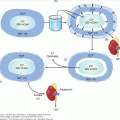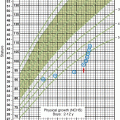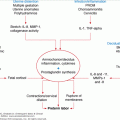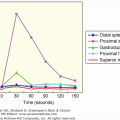Abbreviations
- ACTH Adrenocorticotropic hormone
- ANP Atrial natriuretic peptide
- APUD Amine precursor uptake and decarboxylation (cell)
- CRH Corticotropin-releasing hormone
- CT Computed tomography
- FDG-PET Fluorodeoxyglucose positron emission tomography
- FGF Fibroblast growth factor
- FSH Follicle-stimulating hormone
- GH Growth hormone
- GHRH Growth hormone–releasing hormone
- hCG Human chorionic gonadotropin
- HTLV-1 Human T cell leukemia virus-I
- IGF Insulin-like growth factor
- IGF-BP3 Insulin-like growth factor binding protein-3
- IL Interleukin
- LH Luteinizing hormone
- MEPE Matrix extracellular phosphoglycoprotein
- MRI Magnetic resonance imaging
- POMC Proopiomelanocortin
- PTH Parathyroid hormone
- PTHrP Parathyroid hormone-related protein
- SIADH Syndrome of inappropriate antidiuretic hormone (secretion)
- TNF Tumor necrosis factor
- VIP Vasoactive intestinal peptide
Ectopic Hormone and Receptor Syndromes
Some of the most challenging endocrine problems occur in patients with malignancies of diverse cell types, because both endocrine and nonendocrine tumors secrete polypeptide hormones. As it became recognized that a polypeptide hormone could be produced by tumor cells derived from a tissue that normally did not secrete the hormone, the notion of ectopic hormone production developed. Most tumors associated with ectopic hormone syndromes are derived from cells that are normally capable of producing peptide hormones. Initially, it was thought that ectopic hormone production by tumor cells was a rare event. Interestingly, both the frequency and the original conception of this syndrome have been redefined over the last few decades. It has come to be appreciated—through the use of modern biochemical and molecular biologic techniques—that the synthesis of peptide hormones and the transcription of their genes by tumor cells are in fact quite common occurrences. Tumor cells may differ from normal cells in their ability or inability to process precursor molecules, which may account for the presence or absence of hormone excess states and for the profile of peptide hormone forms and fragments present in the circulation and in tumor cell extracts. However, tumor production of hormone fragments or precursors is much more common than the clinical syndromes of hormone excess.
The classic criteria used to confirm that a tumor is the source of a hormone excess state include the following: (1) evidence of an endocrinopathy in a patient with a tumor; (2) remission of the endocrinopathy after tumor resection; (3) detection of an arteriovenous gradient across the tumor; and (4) documentation of protein and messenger RNA encoding the hormone being produced by tumor tissue.
In addition to classic hormone excess states resulting from the ectopic or inappropriate secretion of a hormone by an endocrine or nonendocrine tumor, endocrinopathies can result from the ectopic expression of a hormone’s receptor. This is well illustrated, for example, by the occurrence of Cushing syndrome in pregnancy or in relation to meals, due to the ectopic expression of luteinizing hormone (LH) or gastric inhibitory polypeptide receptors in adrenal tissue, respectively. Several other examples of ectopic receptor syndromes have been documented. Some of these will be discussed later, particularly as a cause for unusual forms of adrenocorticotropic hormone (ACTH)-independent Cushing syndrome.
A variety of peptides are produced by both benign and malignant tumors as listed in Table 21–1. The biochemical pathways and machinery leading to the synthesis, processing, and secretion into the circulation of a peptide hormone are present in all cells. In contrast, the multiple enzymatic steps that lead to the production of a highly active steroid hormone (eg, cortisol or 1,25–dihydroxyvitamin D [1,25-(OH)2 D]) are restricted, with rare exceptions, to steroid-producing cells or their precursor cells. Hence, the occurrence of 1,25-(OH)2 D excess caused by a tumor is distinctly unusual, being observed infrequently in hematologic malignancies and only in those with the ability to 1-hydroxylate 25-OH D, the immediate precursor of 1,25-(OH)2 D. Ectopic hormone syndromes—the most common of the paraneoplastic syndromes—thus predominantly reflect peptide hormone excess states. The most common ectopic peptide hormone syndromes are described in greater detail in subsequent sections of this chapter.
| Hormone | Syndrome |
|---|---|
| Parathyroid hormone-related protein (PTHrP) | Hypercalcemia |
| Parathyroid hormone (rare) | Hypercalcemia |
| Adrenocorticotropin (ACTH) | Cushing syndrome |
| Corticotropin-releasing hormone (CRH) | Cushing syndrome |
| Antidiuretic hormone (ADH) | Hyponatremia |
| Insulin and insulin-like growth factors (IGF) | Hypoglycemia |
| Growth hormone–releasing hormone (GHRH) | Acromegaly |
| Calcitonin | No specific syndrome |
| Human chorionic gonadotropin (hCG) | Children: precocious puberty Men: erectile dynsfunction, gynecomastia Women: dysfunctional uterine bleeding |
| Fibroblast growth factor (FGF) 23 | Oncogenic osteomalacia |
| Vasoactive intestinal peptide (VIP) | Diarrhea |
Over the years since the initial recognition that nonendocrine tumors were the source of the ectopic hormones produced in these endocrine syndromes, the notion developed that the hormones originated from highly specialized neuroendocrine cells in tumors. These cells were thought to derive from the neural crest and were postulated to be able to synthesize and store biogenic amines and were thus designated as amine precursor uptake and decarboxylation (APUD) cells. Neuroendocrine cells, like calcitonin-secreting C cells and adrenal chromaffin cells, clearly had these properties, and tissues giving rise to ectopic hormone syndromes (eg, lung and gastrointestinal tract) also had APUD cells scattered throughout them. It was originally thought that the tumor cells producing excessive amounts of polypeptide hormones were derived exclusively from APUD cells in the tissue of origin (eg, ACTH-producing cells of the lung).
Newer insights into tumor cell biology have led to a better understanding of the pathogenesis and etiology of the ectopic hormone production states. Studies have shown that not all APUD cells are derived from the neural crest. Some of these cells are of endodermal origin. Furthermore, with careful examination of tumors, it has become clear that peptide hormones are often produced by non-APUD cells. It has, however, been appreciated that the clinically evident hormone hypersecretion states are typically caused by tumors that are in fact derived from APUD cells. These cells are the ones with full capacity to produce and store peptide hormones efficiently in dense secretory granules and then release biologically significant quantities of active hormones in circulating plasma.
Hypercalcemia of Malignancy
Hypercalcemia is the most common paraneoplastic endocrine syndrome, occurring in 25% of malignancies. In the great majority of patients (98%), the identity of the tumor is apparent at the time of presentation, and the prognosis is poor, as most patients with hypercalcemia of malignancy do not survive beyond 6 months.
Elevated serum calcium levels result primarily because of excessive osteoclast-mediated bone resorption. Ectopic hormones produce this effect in bone via two distinct mechanisms: (1) humoral effects of systemically elevated tumor-derived factors and/or (2) local effects of peptide hormones produced by tumor cells within the marrow. When the syndrome of hypercalcemia of malignancy was first described, local effects within bone tumors were thought to be causative. However, in the 1980s, a humoral basis was identified as the most frequent cause (80%), even in settings where focal lytic bone metastases were present. Decreased renal calcium excretion may also contribute to pathogenesis, either because of the hypocalciuric effects of certain humoral mediators of hypercalcemia, such as parathyroid hormone (PTH)-related protein (PTHrP) (discussed later), or because of the decreased glomerular filtration that occurs with hypercalcemia-induced nephrogenic diabetes insipidus.
A humoral cause of hypercalcemia of malignancy was first proposed by Fuller Albright in the 1940s when describing a case occurring in the absence of significant bone metastases. It would take another 50 years for this humoral factor to be identified. It was appreciated early on that the basic biochemical parameters of this syndrome (high serum calcium, low serum phosphorus, elevated nephrogenous cAMP) were suggestive of ectopic PTH production. However, PTH was not the culprit, as serum PTH levels in these cases were actually suppressed. Ultimately, and unlike most other paraneoplastic endocrine syndromes that are caused by well-described hormones of known function, a novel peptide, PTH-related protein (PTHrP), was identified as the humoral mediator of this syndrome in a majority of cases.
As denoted by its name, PTHrP has much in common with PTH. PTHrP was initially so named because of shared biochemical and metabolic effects with PTH. The amino terminal portion of PTHrP bears strong homology to PTH, such that the two peptides bind with similar affinity to PTH receptors (now known as the PTH/PTHrP-1 receptor subtype) in bone and kidney. Therefore, the biochemical markers of PTHrP-mediated hypercalcemia in vivo, when it is produced by tumors in an unregulated fashion, are similar to those of hyperparathyroidism. Some unexplained differences, however, are seen in PTHrP-mediated hypercalcemia of malignancy (vs primary hyperparathyroidism), including normal or suppressed 1,25-(OH)2 D levels and an uncoupling of bone resorption and formation that results in severe bone loss. The reasons for these differences are not understood but are speculated to include: (1) the ability of chronic PTHrP (vs intermittent PTH) stimulation or profound hypercalcemia per se to suppress 1,25-(OH)2 D levels; and (2) the contributions of additional tumor-derived cytokines, such as interleukin (IL)-1α or IL-6, to the process of bone resorption.
Subsequent study of this previously unknown peptide has demonstrated that PTHrP and PTH actually diverge in many critical ways, beginning evolutionarily. Both hormones arose from ancient duplication of a common gene, but evolved separately such that in higher vertebrates, PTH now regulates calcium homeostasis, while PTHrP has critical developmental roles, including endochondral bone growth, tooth eruption, and development of the mammary gland and cardiovascular system. As with other developmentally regulated proteins, PTHrP plays less of a role in adult homeostasis, but can be reexpressed in response to specific changes in gene programming, including pregnancy (calcium regulation by the lactating mammary gland and placenta), injury and inflammation (regulation of vascular tone in ischemia, sepsis, and inflammation-associated bone resorption), and/or tumorigenesis (hypercalcemia of malignancy).
When tumor expression of PTHrP results in inappropriately high levels of PTHrP that reaches bone cells through the circulation or following synthesis in the bone microenvironment, a vicious cycle can ensue. PTHrP stimulates the expression of RANKL (receptor activator of NF-κB ligand) by osteoblasts. RANKL, the primary gatekeeper modulating bone resorption in health and disease, stimulates osteoclast differentiation and function via binding to its receptor, RANK, on osteoclasts and their precursors. Increased numbers of activated osteoclasts are generated both by the local release of PTHrP, in the case of bone metastases, or by high levels of the hormone produced by tumor cells in extraskeletal sites. Both mechanisms cause enhanced bone resorption. In the case of bone metastases, sequestered growth factors, such as transforming growth factor (TGF)-beta, released locally from the bone matrix during resorption, further enhance tumor cell secretion of PTHrP.
Although PTHrP is by far the most common mediator of hypercalcemia of malignancy, other calciotropic hormones can also cause the syndrome. When hypercalcemia occurs with lymphoma, increased circulating levels of 1,25-(OH)2 D are a common cause, due to increased 1α-hydroxylase activity in lymphoproliferative cells and/or tumor-adjacent macrophages. Other tumor-derived bone-resorbing factors, such as prostaglandins, may also contribute to hypercalcemia of malignancy with certain tumors, like renal cell carcinoma. In contrast, ectopic production of PTH is extremely rare, but has occasionally been reported for neuroendocrine tumors and other solid tumors.
The majority of cases of hypercalcemia occurring with solid tumors (80%) are associated with two common tumor types: squamous cell lung carcinoma and breast carcinoma (see Table 21–1). Hypercalcemia is also frequently seen in renal cell carcinoma. Indeed, PTHrP was first isolated and identified by independent research groups each using one of these three tumor types. In contrast, hypercalcemia is rarely seen in other commonly occurring cancers (eg, colon, gastric, thyroid, and small cell lung carcinomas), including some tumors that are frequently metastatic to bone (eg, prostate cancer).
Squamous cell carcinomas account for more than one-third of all cases of hypercalcemia of malignancy. Humoral effects of tumor-derived PTHrP account for most cases of hypercalcemia in this setting, even when bone metastases are present. Twenty-five percent of patients with squamous cell lung carcinomas develop PTHrP-mediated hypercalcemia, and other sites of squamous cell carcinoma (head, neck, esophagus, cervix, vulva, and skin) are similarly associated with a high incidence of hypercalcemia.
The majority of patients with breast cancer bone metastases (ie, 70% of those with advanced disease) do not have hypercalcemia. However, hypercalcemia does occur in 30% of advanced-stage breast carcinoma cases and is only rarely seen in the absence of bone metastases. PTHrP is causative, as both a local and/or humoral factor to stimulate bone resorption. Most breast cancer bone metastases (92%-100%) express PTHrP and cause lytic bone destruction. In addition, humoral effects of PTHrP, as evidenced by elevated circulating levels of PTHrP associated with increased nephrogenous cAMP, have been documented in a majority of cases of hypercalcemia occurring in the absence of bone metastases and two-thirds of those cases occurring with bone metastases.
Despite this close association of PTHrP with advanced disease, the prognostic significance of PTHrP expression in primary breast carcinomas, which has been documented in two-thirds of primary tumors in multiple series, is not clear. Reasons for the lack of a simple direct correlation are probably multifactorial and may include: (1) the ability of tumors to modulate PTHrP expression once they metastasize to bone (eg, TGF-beta released from the bone matrix by invading tumor cells is thought to enhance PTHrP expression in the tumor cells, even when the primary tumor is PTHrP-negative); and (2) the tendency for expression of PTHrP to correlate with estrogen receptor and progesterone receptor status, which influences treatment and response to therapy. Additionally, locally produced bone cytokines such as IL-1α, IL-6, and tumor necrosis factor (TNF)-alpha likely act in concert with PTHrP at sites of bone metastases to enhance osteoclast-mediated lytic bone destruction and thus contribute to hypercalcemia. Hypercalcemia seen in late stages of breast cancer is usually unremitting and associated with a survival time of weeks to months.
Renal cell carcinoma, while less common than squamous cell or breast carcinoma, is also frequently associated with hypercalcemia in advanced cases. While bone metastases are common in advanced disease, hypercalcemia appears to be due primarily to humoral effects of PTHrP. In some series, 100% of renal cell tumors have been reported to stain positively for immunoreactive PTHrP. However, hypercalcemia is reported in less than 20% of cases.
Hypercalcemia is also associated with other solid tumors, although less frequently. In most of these cases, humoral effects of PTHrP are causative. Bladder carcinoma, large cell and adenocarcinoma of the lung, and endocrine tumors (including islet cell tumors, pheochromocytoma, and carcinoid tumors) have also been reported to secrete PTHrP. PTHrP-mediated hypercalcemia has also been reported for ovarian carcinomas. A case of ectopic PTH production by an ovarian carcinoma has also been reported.
Hypercalcemia and lytic bone lesions are among the diagnostic criteria for multiple myeloma, a hematologic malignancy characterized by infiltration of the bone marrow with malignant plasma cells. Lytic bone lesions and active bone resorption occur adjacent to tumor cells, which secrete multiple factors capable of stimulating osteoclast differentiation and activity. A major effect of these factors, which include macrophage inflammatory peptide-1, TNF-alpha, IL-1, and IL-6, is to induce RANKL expression in osteoblasts. Evidence of RANKL expression by plasma cells also exists. Locally increased RANKL causes bone lysis by binding to its cognate receptor on osteoclasts (RANK) and stimulating their differentiation and activity. More recently, it has been appreciated that defects in bone formation, due to suppression of the Wnt signaling pathway by other tumor factors (eg, Dickkopf-1), also accompany lytic bone disease in multiple myeloma. In 30% of cases, bone lysis leads to hypercalcemia. Because renal disease occurs frequently in myeloma due to the filtration of Bence Jones proteins (light chain fragments of IgG), it is hypothesized that patients with renal impairment may be particularly predisposed to development of hypercalcemia in this setting of increased bone resorption.
| Incidence of Hypercalcemia | Etiology of Hypercalcemia | ||
|---|---|---|---|
| Solid tumors | Humoral | Local lytic | |
| Squamous cell (lung, head, neck) | 25% | 100% (PTHrP) | – |
| Breast, advanced | 30% | 65% (PTHrP) | 35% (PTHrP) |
| Renal cell | 15% | 50%-100% (PTHrP) | 50% |
| Hematologic malignancies | |||
| Multiple myeloma | 30% | – | 100% |
| Lymphoma/leukemia (non-HTLV-1) | <15% | 50% (1,25[OH]2D, rarely PTHrP) | 50% |
| HTLV-1 lymphoma/leukemia | 66% | 100% (PTHrP) | – |
Hypercalcemia has been reported in up to 15% of patients with lymphoma; is seen primarily in patients with bone involvement; and can occur with a variety of cell types. In most cases, the etiology is evenly divided between: (1) local lytic effects of tumor-derived factors within the marrow, analogous to the mechanisms discussed for myeloma, or (2) humoral effects of tumor-derived 1,25-(OH)2 D. 1, 25(OH)2 D-mediated hypercalcemia of malignancy is unique to lymphoma. Its underlying pathology is analogous to that seen in hypercalcemia in granulomatous disorders where 1α-hydroxylase activity in the abnormal hematopoietic cells or infiltrating macrophages results in unregulated conversion of 25-(OH)2 D to active 1,25-(OH)2 D. Increased intestinal calcium absorption and increased bone resorption are both thought to contribute to hypercalcemia in this setting. In addition, there are also numerous case reports of humoral effects of tumor–derived PTHrP as a cause of hypercalcemia in non-Hodgkin lymphomas (particularly B cell), acute lymphoblastic leukemia, and blast crises in chronic myeloid leukemia. So the clinician confronting such tumors must be cognizant of the different etiologies for the observed hypercalcemia.
Patients diagnosed with adult T cell leukemia or lymphoma induced by HTLV-1 (human T cell lymphotrophic virus-1), the first identified human retrovirus, must be considered separately when evaluating possible causes of hypercalcemia. In these patients, hypercalcemia occurs in two-thirds of cases, responds poorly to treatment, and is due to the humoral effects of tumor-derived PTHrP. Tax1, a transcription factor encoded by the HTLV-1 genome, transforms T cells in these cases by altering the regulation of hundreds of host genes, including transactivation of PTHrP.
The diagnosis of hypercalcemia is discussed in detail in Chapter 8. Primary hyperparathyroidism and hypercalcemia of malignancy account for more than 90% of all causes of hypercalcemia. Because the incidence of primary hyperparathyroidism is twice that of hypercalcemia of malignancy, primary hyperparathyroidism must always be considered as a potential cause of hypercalcemia in patients with malignancy and can be screened for by simply determining intact PTH levels using a standard two-site immunoradiometric assay. In the setting of hypercalcemia of malignancy with normal renal function, PTH levels are suppressed. Further evaluation can be guided, in part, by the tumor type, which is usually known prior to presentation with hypercalcemia. Elevated PTHrP is detected in a majority of cases of hypercalcemia of malignancy associated with solid tumors, including breast carcinoma with or without bone metastases, and in HTLV-1–induced T cell lymphomas. Measurement of 1,25-(OH)2 D should be considered in all cases of lymphoma-associated hypercalcemia. Lytic bone lesions are usually identified during tumor staging.









